How to craft the perfect carpenter resume
Carpenter jobs, like most roles that rely on people that are great with their hands, are often in exceptionally high demand. But, conversely, those that can prove that they have the talent and experience to make a difference in projects will never go short of work. It’s one of those sectors where word of mouth can go a long way towards contributing to success.
However, many of the most attractive roles out there will, as in industry, hinge on getting a foot in the door with an outstanding carpenter resume.
A fantastic resume for carpenters generally follows the same core principles as the same documents in any other profession. You want to make it compact, easy to read, and, above all, attention-grabbing. The chances are that you’re not the only person applying for a role, especially if it’s appealing enough to go out of your way for. Similarly, hiring managers often don’t have the time to read every single word on your resume unless you can give them a great reason to do precisely that.
Whether you’re a master craftsperson or brand new to the industry, it’s all about grabbing a recruiter’s attention and not letting go until they’re convinced that you’re the right person for the job. Of course, as noted, many of the typical resume writing basics apply. Still, the following tips will take your application to a whole new level and ensure you stand out in the crowd, no matter the competition levels.
1. Give past projects the attention they deserve
Carpentry is something of an outlier in the world of work, as you can often provide evidence of your biggest successes.
Now, that’s not to say that you should replace your resume with a photo gallery of your best jobs. However, you shouldn’t be afraid to talk about them in the glowing terms they deserve.
In terms of your resume, that means drawing attention to your most significant successes at every available opportunity. It all starts with your resume summary – or resume objective if you’ve got less than two years of experience in the field.
Great resumes start with an excellent summary, and yours might look something like this one, taken from our resume library:
"Hard-working and results-driven Carpenter adept at performing various carpentry duties. Offers a highly professional attitude, great manual dexterity, technological expertise, and extensive knowledge of math and geometry. Certified Lead Carpenter with a proven track record of success in completing all projects in a timely manner and in compliance with clients’ needs. Presently looking for a Carpenter position with a modern, flexible, and customer-oriented company."
As you can see, this summary grabs the attention by foregoing the basics and bringing real-world experience to the fore.
Like many manual jobs, recruiters make certain assumptions about applicants. Just as they wouldn’t expect an applicant for a doctor’s role to have skipped medical school, they’ll have a fair idea of your capabilities with your hands. In short, carpentry applicants with no idea what it means to be a carpenter are few and far between.
That saves you time and space, enabling you to devote more of it to the highlights. In the above example, the applicant points out that they’re a Certified Lead Carpenter. In an industry where qualifications and certifications can vary wildly, that’s the kind of information that will make a hiring manager hungry to read more.
Crucially, this statement also touches on both hard and soft skills. For example, you might be the most extraordinary carpenter in the region, but if you want a customer-facing role and aren’t too fond of people, it might not be the greatest fit.
In this particular case, the applicant demonstrates that they’re not only solid in the basics but also understand the theory in great design afforded by math and geometry. They’re also comfortable with the technology that enables them to make it happen.
2. Tailor past experience on your carpenter resume to the next role
You might only have a vague job description to work with when envisioning yourself in the next role. However, that should be more than sufficient to guide you on where your experience will best shine through next. As with most roles, you’ll want to list your experience in reverse-chronological order, meaning the most recent roles first. From there, you need to highlight the parts of the job in which you performed best while giving the recruiter something to work with.
Again, they’ll assume you did the core job well, so use your valuable bullet points to make your application even more relevant. Allocate the most space to more recent roles and talk about genuine achievements. By all means, be descriptive, but if the opportunity arises to mention numbers, such as beating a deadline by a certain number of weeks or using different methodologies for actual cost savings, make those numbers stand out.
It’s also worth bearing in mind that fully tailored resumes tend to perform best. Some people keep one resume on hand and use it for every application. Others will rewrite their job histories for every role, even with minor tweaks. The latter usually leads to the most success, so don’t be afraid to switch bullet points and experience in and out depending on the demands of the next role. Remember, you can always keep the parts you don’t use in a draft file for when they’re more relevant.
3. Don’t go overboard on education
Carpentry is one of those disciplines whereby a certain level of education is expected, but it loses relevance in favor of experience relatively quickly. You often require nothing more than a GED for entry-level roles, which once again stems from the fact that the desire to become a carpenter alone can usually get your foot in the door.
In most cases, the following will apply:
- If you’ve completed college, list the name, location and dates attended. Don’t worry about high school.
- If you’re still in college at the time of the application, list both the college and the high school.
- If you’ve only completed high school, include it on your resume but keep it concise.
In conclusion...
While this general guidance applies to most carpenter resumes, it can differ if you’ve got something particularly impressive to include. For example, if you have specific qualifications in woodworking, they warrant a mention. However, if your education is more general, don’t feel like you need to add to it just to fill space. That space is far better utilized on experience and goals.
Overall, carpenter resumes tend to benefit from certain assumptions, leaving you to focus on ensuring that your objectives and experiences have the time and space to seal the deal!

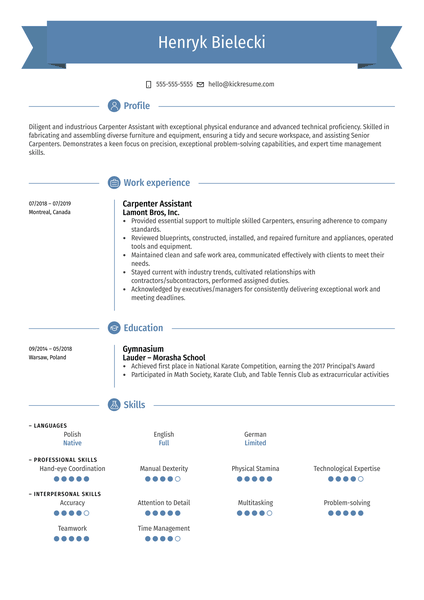
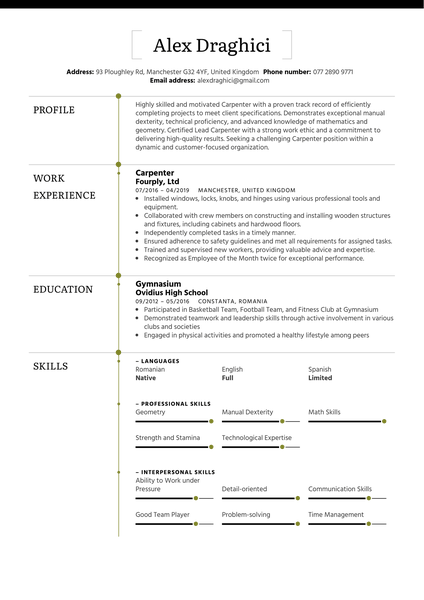
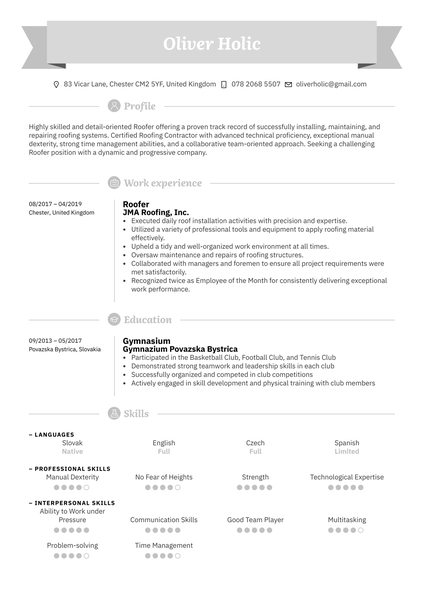

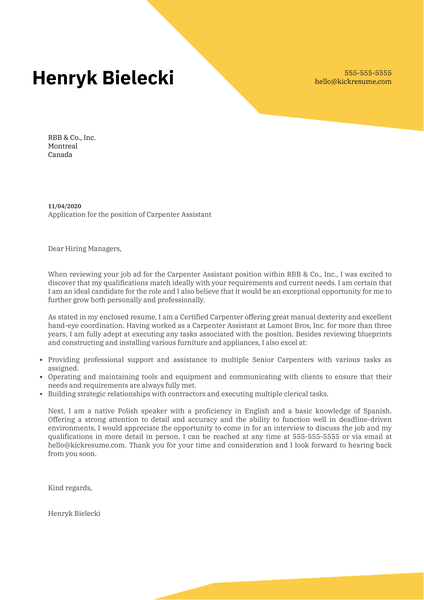
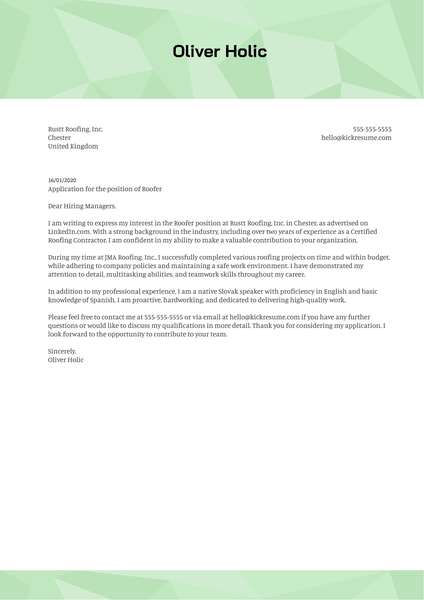
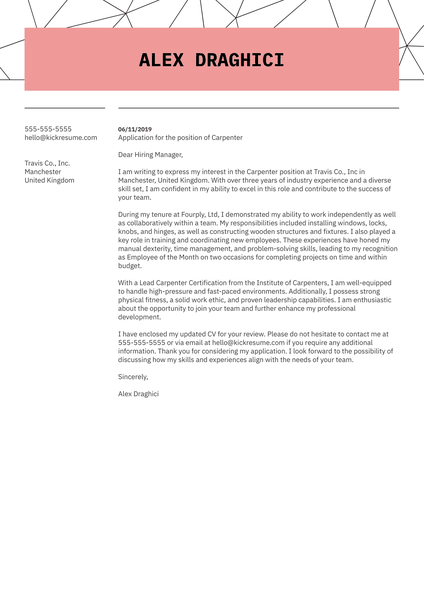
![How to Write a Professional Resume Summary? [+Examples]](https://d2xe0iugdha6pz.cloudfront.net/article-small-images/i-Profile.svg)
![How to Put Your Education on a Resume? [+Examples]](https://d2xe0iugdha6pz.cloudfront.net/article-small-images/i-Collage-Universities.svg)
![How to Describe Your Work Experience on a Resume? [+Examples]](https://d2xe0iugdha6pz.cloudfront.net/article-small-images/Experience.svg)


